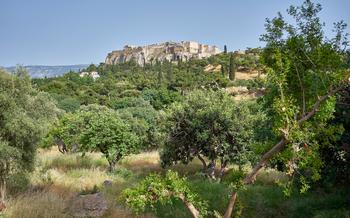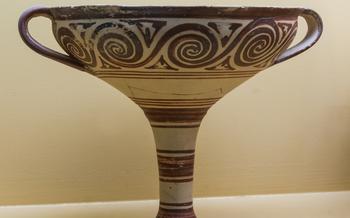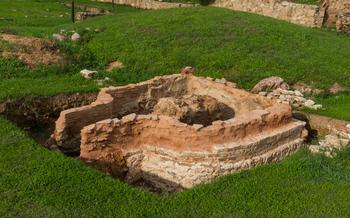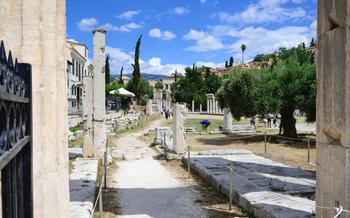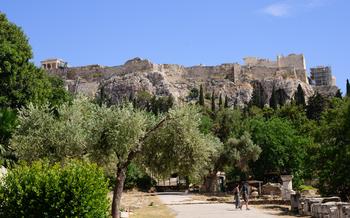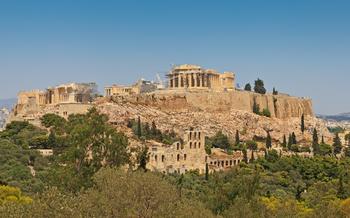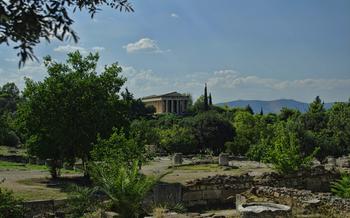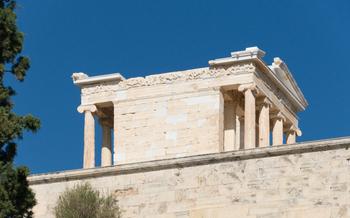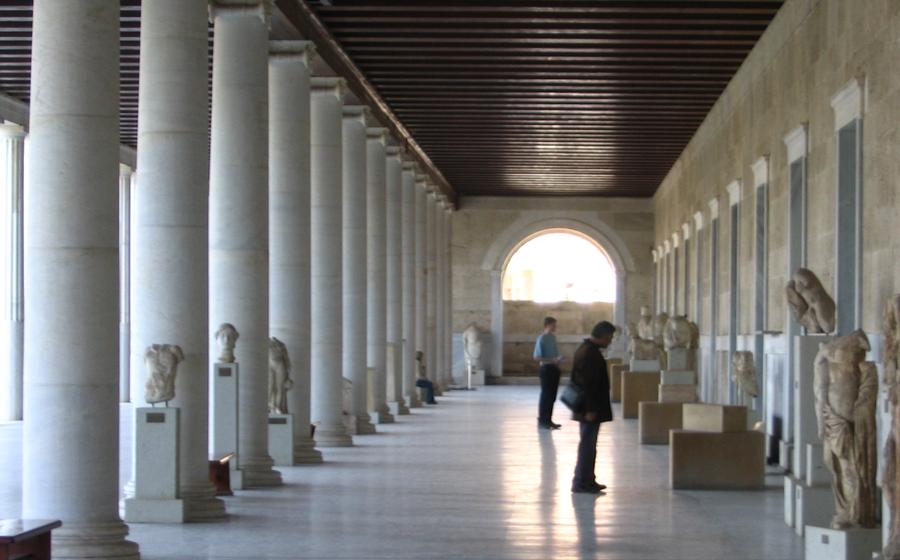
Stoa of Attalos
- Explore the Ancient Marketplace: Stoa of Attalos
- Location and Accessibility
- Architectural Features
- Stoic Philosophers: Engaging in Intellectual Discourse
- Agora Museum: Delving into the Ancient Agora's Stories
- Temple of Hephaestus
- Photography Opportunities
- Historical Reenactments
- Combining Ancient and Modern
- Hidden Gems
- Souvenirs and Local Crafts
- Food and Drink
- Tips for Visiting:
- Insider Tip: Sunset Magic
Explore the Ancient Marketplace: Stoa of Attalos
In the heart of Athens, nestled within the ruins of the Ancient Agora, stands the Stoa of Attalos, a reconstructed marketplace that transports visitors back in time to the bustling commercial and social hub of ancient Greece. This iconic stoa, dating back to the 2nd century BC, was meticulously rebuilt in the 1950s, offering a glimpse into the architectural brilliance and vibrant atmosphere of the Hellenistic period.
As you step through the grand entrance, adorned with Doric columns and intricate carvings, you can almost hear the echoes of merchants haggling over prices, philosophers engaging in lively debates, and shoppers browsing for goods from across the Mediterranean. The stoa's two-story structure, with shops lining the ground floor and offices above, showcases the ingenuity of ancient Greek architecture.
More than just a marketplace, the Stoa of Attalos was also a gathering place for Stoic philosophers like Zeno of Citium, who founded the Stoic school of philosophy. These philosophers sought wisdom and virtue through self-control, courage, and reason, leaving a lasting impact on Western thought.
Today, the restored Stoa of Attalos stands as a testament to the grandeur of ancient Athens and invites visitors to immerse themselves in the rich history and cultural heritage of Greece.
Location and Accessibility
The Stoa of Attalos is conveniently located in the heart of Athens, within the Ancient Agora. To reach it, take the metro to the "Thissio" station and follow the signs to the Agora. The stoa is just a short walk from the metro exit. Once you arrive, you'll be surrounded by other significant ancient landmarks, including the Temple of Hephaestus, the Museum of the Ancient Agora, and the Odeon of Agrippa. The proximity to these attractions makes it easy to combine a visit to the Stoa of Attalos with a broader exploration of the Agora and its rich history. Whether you choose to join a guided tour or explore at your own pace, you'll find that the Stoa of Attalos is easily accessible and well-integrated into the surrounding neighborhood.
Architectural Features
The Stoa of Attalos stands as a testament to the architectural prowess of the ancient Greeks. Its distinctive Doric columns, each standing tall and proud, line the stoa's facade, creating a sense of grandeur and symmetry. The entablature above the columns features intricate carvings and moldings, adding a touch of elegance to the structure. The pediment, triangular in shape, is adorned with sculptures that depict scenes from Greek mythology, showcasing the artistry and craftsmanship of the ancient Greeks.
The stoa's two-story design is another remarkable feature. The ground floor consists of a series of shops, each with its own entrance and display area. The upper floor, accessed by a grand staircase, features a row of offices and meeting rooms, suggesting that the stoa was not only a center of commerce but also a place of intellectual discourse and philosophical exchange.
The restoration efforts undertaken in the early 20th century have brought the Stoa of Attalos back to its former glory. Careful attention was paid to every detail, from the reconstruction of the columns and entablature to the replication of the intricate carvings and sculptures. The result is a stunningly accurate representation of an ancient Greek stoa, allowing visitors to experience the architectural splendor of the Hellenistic period firsthand.
Stoic Philosophers: Engaging in Intellectual Discourse
In the bustling marketplace of the Stoa of Attalos, a group of philosophers gathered to exchange ideas and engage in intellectual discourse. These were the Stoics, a school of philosophy founded by Zeno of Citium in the 3rd century BC. The Stoics believed in the pursuit of virtue, self-control, courage, and reason as the path to happiness and fulfillment.
They rejected excessive emotions and desires, emphasizing the importance of living in harmony with nature and the rational order of the universe. The Stoa of Attalos served as a meeting place for these philosophers, who engaged in lively debates and discussions on ethics, metaphysics, and the nature of reality.
Their teachings influenced Western thought for centuries, shaping the philosophical landscape of ancient Greece and Rome. Even today, Stoicism continues to resonate with people seeking wisdom and guidance in navigating the complexities of modern life. As you explore the Stoa of Attalos, imagine the echoes of these ancient philosophers' voices, reminding us of the enduring power of reason and virtue.
Agora Museum: Delving into the Ancient Agora's Stories
Enrich your understanding of the Ancient Agora by visiting the nearby Agora Museum, a treasure trove of artifacts and insights into the daily life, politics, and administration of ancient Athens. Explore the museum's collection of pottery, tools, sculptures, and other artifacts unearthed during excavations at the site. Interactive exhibits bring history to life, allowing you to immerse yourself in the bustling atmosphere of the ancient marketplace, witness political debates, and learn about the city's intricate administrative system. The Agora Museum is a must-visit for anyone seeking a deeper connection with the rich heritage of Athens.
Temple of Hephaestus
Just steps away from the Stoa of Attalos stands the well-preserved Temple of Hephaestus, an architectural marvel dedicated to the Greek god of metalworking and craftsmanship. Built in the 5th century BC, the temple is a testament to the skill and artistry of ancient Greek builders. Its Doric columns, intricately carved pediments, and well-proportioned facade exude an aura of timeless beauty. As you approach the temple, take a moment to admire its impressive dimensions and the harmonious balance of its architectural elements. The Temple of Hephaestus is a symbol of Athens' rich cultural heritage and a reminder of the city's enduring legacy as a center of art and craftsmanship. Ongoing restoration efforts aim to preserve this iconic landmark for generations to come, ensuring that its grandeur continues to inspire awe and admiration.
Photography Opportunities
The Stoa of Attalos, with its imposing columns and intricate carvings, presents a wealth of photography opportunities. Capture the grandeur of this ancient marketplace from various angles and perspectives. Experiment with different focal lengths and compositions to showcase its unique features. Take advantage of the natural light during golden hour, when the warm hues of the sunset illuminate the stoa's facade, creating dramatic and captivating shots. Share your stunning photos on social media using relevant hashtags to connect with other travelers and photography enthusiasts. Let your images bring the ancient world to life and inspire others to explore the wonders of Athens.
Historical Reenactments
Immerse yourself in the vibrant history of Athens by attending one of the many historical reenactments or performances that take place in the Ancient Agora. These events bring the ancient city back to life, allowing visitors to experience the sights, sounds, and customs of ancient Greece.
Watch as actors dressed in traditional attire reenact scenes from everyday life, religious ceremonies, and political debates. Learn about the daily rituals, customs, and traditions of the ancient Greeks as they go about their daily lives.
Historical reenactments are a fantastic way to engage with the past and gain a deeper understanding of the culture and history of ancient Athens. They offer a unique and immersive experience that will transport you back in time to the birthplace of democracy.
So, if you're looking for a truly memorable and educational experience, be sure to attend a historical reenactment at the Ancient Agora. It's a chance to step back in time and experience the magic of ancient Greece firsthand.
Combining Ancient and Modern
Athens is a city where the past and present coexist in harmony. The Stoa of Attalos stands as a testament to the city's rich history, while the surrounding modern metropolis buzzes with activity. The integration of the ancient ruins into the contemporary urban landscape creates a unique and captivating atmosphere.
The Stoa of Attalos has been skillfully incorporated into the fabric of modern Athens. Its restored columns and shops now house various businesses, including cafes, restaurants, and art galleries. Visitors can admire the ancient architecture while enjoying the conveniences of modern amenities. The stoa has become a vibrant hub where locals and tourists alike can mingle, shop, and dine amidst the echoes of history.
The coexistence of the ancient and the modern in Athens is a reminder of the city's enduring spirit. While the city embraces progress and development, it also cherishes and preserves its rich heritage. The Stoa of Attalos serves as a symbol of this delicate balance, inviting visitors to explore the layers of history that make Athens such a captivating destination.
Hidden Gems
As you explore the Ancient Agora, keep an eye out for hidden gems that offer a glimpse into the daily life of ancient Athenians. One such gem is the Odeon of Agrippa, a small theater built in the 1st century BC. Originally used for musical performances, it now hosts occasional concerts and events.
Another hidden gem is the Metroon, a sanctuary dedicated to the mother of the gods. Built in the 5th century BC, it was used to store official documents and religious artifacts. Today, it houses a small museum with exhibits on the history of the Agora.
Venture off the beaten path and discover these hidden treasures to gain a deeper understanding of ancient Athenian culture and history.
Souvenirs and Local Crafts
As you stroll through the ancient Agora, don't miss the opportunity to shop for unique souvenirs and local crafts inspired by the Stoa of Attalos and ancient Greece. From charming pottery and intricate jewelry to handcrafted leather goods and artisanal products, there's something for every taste and budget. Support local artisans and businesses by purchasing their creations, and take home a piece of Athens to cherish and remember your visit. Whether you're looking for a gift for a loved one or a special memento for yourself, you're sure to find something truly special amidst the vibrant offerings of the Agora.
Food and Drink
After exploring the ancient ruins of the Stoa of Attalos and the surrounding Agora, indulge in the delectable culinary delights that Athens has to offer. Numerous restaurants and cafes line the streets near the stoa, offering a diverse array of dining options to satisfy every palate.
Savor the authentic flavors of traditional Greek cuisine, such as moussaka, a hearty dish of eggplant, potatoes, and minced meat topped with a creamy béchamel sauce. Delight in souvlaki, succulent skewers of grilled meat, often served with pita bread, fresh vegetables, and tzatziki sauce. And don't forget to end your meal with a sweet treat like baklava, a filo pastry filled with nuts and honey syrup.
Pair your meal with a refreshing glass of local wine or indulge in the rich aroma of Greek coffee. Sip on a traditional freddo cappuccino, a cold, frothy coffee beverage, or enjoy a leisurely cup of Greek coffee, prepared in a small pot called a briki and served with a side of cold water.
As you savor the delicious food and drinks, take a moment to appreciate the vibrant culinary scene of Athens, where ancient traditions blend harmoniously with modern gastronomy.
Tips for Visiting:
Shoulder Season Bliss: Opt for the shoulder seasons (spring or fall) to escape the throngs of summer tourists and bask in the mild weather, making your exploration even more enjoyable.
Comfortable Footwear: Prepare for uneven terrain by wearing comfortable shoes that provide good support. The ancient streets and pathways can be rugged, so sturdy footwear is essential.
Capture the Moment: Bring your camera to immortalize the beauty of the Stoa of Attalos and its surroundings. The intricate carvings, imposing columns, and ambient atmosphere are all worthy of capturing.
Free Admission Delight: Take advantage of the free admission to the Ancient Agora, including the Stoa of Attalos. Embrace the opportunity to immerse yourself in history without any financial burden.
Sunset Magic: Discover the enchanting allure of the Stoa of Attalos at sunset. As the sun dips below the horizon, the play of light and shadow on the columns creates a magical ambiance that's not to be missed.
Insider Tip: Sunset Magic
For an unforgettable experience, time your visit to the Stoa of Attalos at sunset. As the sun dips below the horizon, the stoa's columns cast long shadows that dance across the ancient stones. The golden light illuminates the intricate carvings and architectural details, creating a magical atmosphere that transports you back in time. Capture this enchanting moment with your camera or simply soak in the beauty of the stoa as it transforms under the fading light. Whether you're a history buff, an architecture enthusiast, or simply a traveler seeking unique experiences, witnessing the sunset at the Stoa of Attalos is an unforgettable moment that will leave a lasting impression.
